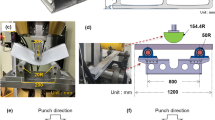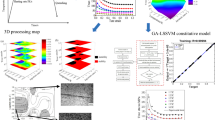Abstract
Hot compression tests of the 6063 aluminum alloy were conducted using a Gleeble-3500 thermal simulation testing machine, and the stress–strain curves at different temperatures and strain rates were obtained. The Kocks–Mecking–Estrin (KME) constitutive model was used to describe the rheological properties, and the initial parameters were identified based on experimental data. The final parameters were identified by the inverse analysis method. The KME model was embedded in a plane compression finite element model by the ABAQUS UHARD subroutine. The multidisciplinary optimization design software ISIGHT was used to integrate the finite element method simulation and relative error calculation. A minimal relative error between the experimental and simulated results was set as the objective, and a multi-island genetic optimization algorithm was used to identify the constitutive parameters. The results showed good agreement between the simulated and measured compression specimen shapes, and the global error between the numerical and measured force–displacement data was only 3.8%. The inverse analysis method was more accurate than the fitting method in identifying the constitutive parameters. The extrusion of a round bar was simulated, and both temperature and extrusion force were accurately predicted by using this constitutive model, further proving that the inverse analysis method used in the present study is effective in identifying the constitutive parameters.
















Similar content being viewed by others
References
R.H. Wu, Y. Liu, Y. Xiao, J.R. Xu and Q.Q. Lin, Study on Hot Deformation Behavior and Intrinsic Workability of 6063 Aluminum Alloys Using 3D Processing Map, J. Alloys. Compd., 2017, 713, p 212–221.
H. Zhu, C. Qin, J.Q. Wang and F.J. Qi, Characterization and Simulation of Mechanical Behavior of 6063 Aluminum Alloy Thin-Walled Tubes, Adv. Mater. Res., 2011, 198, p 1500–1508.
Z.D. Xie, Y.J. Guan, J. Lin, J.Q. Zhai and L.H. Zhu, Constitutive Model of 6063 Aluminum Alloy Under the Ultrasonic Vibration Upsetting Based on Johnson-Cook Model, Ultrasonics, 2019, 96, p 1–9.
T. Ye, L.X. Li, P.C. Guo, G. Xiao and Z.M. Chen, Effect of Aging Treatment on the Microstructure and flow Behavior of 6063 Aluminum Alloy Compressed Over a Wide Range of Strain Rate, Int. J. Impact. Eng., 2016, 90, p 72–80.
H. Mecking and U.F. Kocks, Kinetics of Flow and Strain-Hardening, Acta. Metall., 1981, 29(11), p 1865–1875.
J. Blaizot, T. Chaise, D. Nélias, M. Perez, S. Cazottes and P. Chaudet, Constitutive Model for Nickel Alloy 690 at Various Strain Rates and Temperatures, Int. J. Plast., 2016, 80, p 139–153.
H. Zhong, P.A. Rometsch, L.C. Cao and Y. Estrin, The Influence of Mg/Si Ratio and Cu Content on the Stretch Formability of 6xxx Aluminium Alloys, Mater. Sci. Eng. A, 2015, 651, p 688–697.
P.T. Summers, A.P. Mouritz, S.W. Case and B.Y. Lattimer, Microstructure-Based Modeling of Residual Yield Strength and Strain Hardening After Fire Exposure of Aluminum Alloy 5083–H116, Mater. Sci. Eng. A, 2015, 632, p 14–28.
A. Bahrami, A. Miroux and J. Sietsma, Modeling of Strain Hardening in the Aluminum Alloy AA6061, Metal. l. Mater. Trans. A, 2013, 44(5), p 2409–2417.
K. Changela, H. Krishnaswamy and R. Kumar, Mechanical behavior and deformation kinetics of aluminum alloys processed through cryorolling and subsequent annealing, Metal l Mater Trans A, 2020, 51(2), p 648–666.
L. Wang, F. Liu, Q. Zuo and C.F. Chen, Prediction of Flow Stress for N08028 Alloy Under Hot Working Conditions, Mater. Des., 2013, 47, p 737–745.
N.Y. Zolotorevsky, A.N. Solonin, A.Y. Churyumov and V.S. Zolotorevsky, Study of Work Hardening of Quenched and Naturally Aged Al–Mg and Al–Cu Alloys, Mater. Sci. Eng. A, 2009, 502, p 111–117.
K.K. Mehta, R.K. Mandal and A.K. Singh, Orientation Dependent Work Hardening Behavior of Cold Rolled and Solution Annealed Hastelloy C-276 alloy, Mater. Today., 2017, 4(2), p 277–284.
A. Giuliano, D. Riccardo, R. Dario, G. Marcin and Z. Franco, The Role of Microstructure on the Tensile Plastic Behaviour of Ductile Iron GJS 400 Produced Through Different Cooling Rates—Part II: Tensile Modelling, Metals Open Access Metal. J., 2019, 9(9), p 1019–1030.
H. Cho and T. Altan, Determination of Flow Stress and Interface Friction at Elevated Temperatures By Inverse Analysis Technique, J. Mater. Process. Technol., 2005, 170(1–2), p 64–70.
G. Wang, L.X. Li, B. Liu and X.Q. Li, Constitutive Parameters Identification of 6061 Aluminum Alloy During Hot Deformation with Inverse Methods, Trans. Nonferr. Metal. SOC., 2011, 021(12), p 3011–3018.
J.M. Zhou, L.H. Qi and G.D. Chen, New Inverse Method for Identification of Constitutive Parameters, Trans. Nonferr. Metal. SOC., 2006, 016(1), p 148–152.
M.T. Anaraki, M. Sanjari and A. Akbarzadeh, Modeling of High Temperature Theological Behavior of AZ61 Mg-Alloy Using Inverse Method and ANN, Mater. Des., 2008, 29(9), p 1701–1706.
C.S. Zhang, J. Ding, Y.Y. Dong, G.Q. Zhao, A.J. Gao and L.J. Wang, Identification of Friction Coefficients and Strain-Compensated Arrhenius-Type Constitutive Model by a Two-Stage Inverse Analysis Technique, Int. J. Mech. Sci., 2015, 98, p 195–204.
T. Sakai, A. Belyakov, R. Kaibyshev, H. Miura and J.J. Jonas, Dynamic and Post-Dynamic Recrystallization Under Hot, Cold and Severe Plastic Deformation Conditions, Prog. Mater. Sci., 2014, 60, p 130–207.
Y. Estrin and H. Mecking, A Unified Phenomenological Description of Work Hardening and Creep Based on One-Parameter Models, Acta. Metall., 1984, 32(1), p 57–70.
Y.C. Lin and X.M. Chen, A Critical Review of Experimental Results and Constitutive Descriptions for Metals and Alloys in Hot Working, Mater. Des., 2011, 32(4), p 1733–1759.
A. Momeni, S. Kazemi and A. Bahrani, Hot Deformation Behavior of Microstructural Constituents in a Duplex Stainless Steel During High-Temperature Straining, Int. J. Min. Met. Mater., 2013, 020(010), p 953–960.
S.K. Li, L.X. Li, Z.W. Liu and G. Wang, Effect of Extrusion Speed on Weld Strength of 6063 square tube, Trans. Nonferr. Metal. SOC., 2017, 29(9), p 1775–1784.
E. Sinha and B.S. Minsker, Multiscale Island Injection Genetic Algorithms for Groundwater Remediation, Adv. Water. Resour., 2007, 30(9), p 1933–1942.
F. Fereshteh-Saniee, I. Pillinger and P. Hartley, Friction Modelling for the Physical Simulation of the Bulk Metal Forming Processes, J. Mater. Process. Technol., 2004, 153–154, p 151–156.
W.R. Hou, Z.H. Zhang, J.X. Xie, Q.M. Ma and H.T. Gai, Temperature Inhomogeneity on Cross Section of Al Alloy Hollow Profile Based on Reverse Point Tracking Method, Chin. J. Nonferrous Metals, 2015, 25(7), p 1798–1807.
L. Li, H. Zhang, J. Zhou, J. Duszczyk, G.Y. Li and Z.H. Zhong, Numerical and Experimental Study on the Extrusion Through a Porthole Die to Produce a Hollow Magnesium Profile with Longitudinal Weld Seams, Mater. Des., 2008, 29(6), p 1190–1198.
W.H.V. Geertruyden, W.Z. Misiolek and P.T. Wang, Surface Grain Structure Development During Indirect Extrusion of 6xxx Aluminum Alloys, J. Mater. Sci., 2005, 40(14), p 3861–3863.
S. Kaneko, K. Murakami and T. Sakai, Effect of the Extrusion Conditions on Microstructure Evolution of the Extruded Al–Mg–Si–Cu Alloy Rods, Mater. Sci. Eng. A, 2009, 500(1–2), p 8–15.
Funding
This work was supported by the National Natural Science Foundation of China [grant numbers U20A20275, 51975201]; the Foundation of Zhejiang Province Key Laboratory of Automobile Safety [grant number GL/20-002X] and the Natural Science Foundation of Hunan Province, China [grant number 2019JJ50054].
Author information
Authors and Affiliations
Contributions
LX contributed to the conception of the study; ZY, JL, ZX performed the experiment; CX, HH contributed significantly to analysis and manuscript preparation; LL helped perform the analysis with constructive discussions.
Corresponding author
Ethics declarations
Conflict of interest
The authors declare that we do not have any financial and personal relationships with others people or organizations that can inappropriately influence our work. In addition, there is no professional or other personal interests of any nature or kind in any product, service and company for this work.
Additional information
Publisher's Note
Springer Nature remains neutral with regard to jurisdictional claims in published maps and institutional affiliations.
Rights and permissions
About this article
Cite this article
Xu, L., Yao, Z., Liu, J. et al. Constitutive Model Parameter Identification for 6063 Aluminum Alloy Using Inverse Analysis Method for Extrusion Applications. J. of Materi Eng and Perform 30, 7449–7460 (2021). https://doi.org/10.1007/s11665-021-05897-9
Received:
Revised:
Accepted:
Published:
Issue Date:
DOI: https://doi.org/10.1007/s11665-021-05897-9




